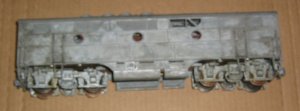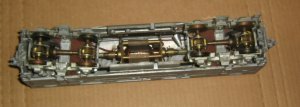Nobody has explained the specifics of why they overheat. All I know it has something to do with the sinewave of electronic transformers. Electronic transformers don't produce a symmetrical (is that the right word?) sinewave. They go up smooth but tend to chop off at the end.
OK I'll try.
Part 1. Motors have coils. The only reason a motor (or any coil for that matter) has resistance at all is because the coil produces a magnetic field that generates its own feedback (back emf). Each time power is supplied the magnetic field has to be built up, as the power goes away it collapses. AC motors create and collapse this field 60 times per second in the US, 50 times in Europe. Depending on the design of the coil, the core of the coil, the size, shape, and material of the wire will determine how much heat is generated in this process. (As an aside, yes - square wires actually make better coils than round ones. The best stereo speakers have square wire in their coils.)
Part 2. Straight AC power has a sign wave that will rise to a maximum of the track voltage. Full throttle will be 18 volts, half throttle will be 9 volts.
Part 3. As Bruette said the power coming from the new electronic power supplies is not a real sign wave. It goes up smoothly, but it goes up to the full 18 volts every single wave. To provide less power to the track the duration of the wave is cut short (chopped). So at half throttle, instead of the power going up to 9 volts and then coming down (lets say it took 1/120th of a second to do that), it goes up to a full 18 volts (but only for 1/240th of a second). This provides the same 1/2 power but it is doing it by limiting the amount of current that can get to the track in that smaller amount of time. The slower the throttle setting the more like "pulse" power this is.
SO - Motors overheat because the are being slammed with full power 120 times a second (positive and negative). In general nothing likes to be slammed with power. The motor has to build the entire magnetic field for a full 18V each time. Plus many of these motors do not have fixed magnets but use electro-magnets which have to do the same thing with their coils. Certain designs are more forgiving or can dissipate the heat better, others simply overheat.
This is very similar to what people experience with coreless motors and DCC decoders. The decoders produce pulses rather than nice smooth DC power the motors were designed to operate off of.
The reason all this happens is that because it is very easy to produce an electronic circuit that generates pulses and very hard to make one that produces a wave (a reason the term "'good' digital music" is an oxymoron).
And then a rant. The whole reason Lionel, Marx, and American Flyer originally went with AC power was because the supplies could be built cheaper. No need to use expensive silicon rectifiers. Now that diodes are so cheap, they have to be spending much more than that trying to create and deal with the problems caused by this pulsed AC power substitute. With the imbedded base of historical locomotives out there, why they don't just spend the money and design a true sine wave output unit is beyond me. Since there is only 1 frequency the fourier transformation for it has to be well documented and associated circuits in use by power conversion companies all over the world.





